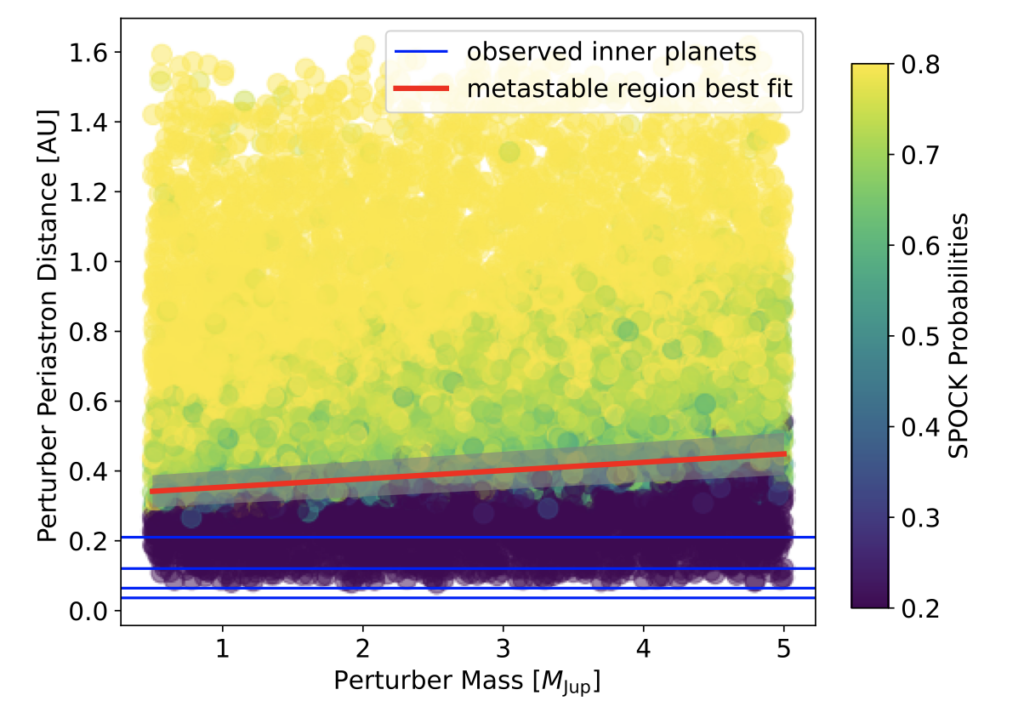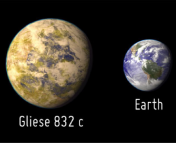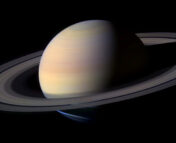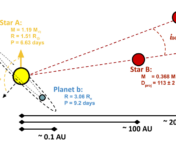Title: Can Cold Jupiters Sculpt the Edge-of-the-Multis?
Authors: Nicole Sobski and Sarah Millholland
Authors’ Institution: Wellesley College and MIT
Status: Preprint available on arXiv
The Kepler mission revealed thousands of transiting exoplanets. Through this unique data set, we have come to understand much more about exoplanet demographics and the occurrence rates of different kinds of planets. In particular, we now understand that the most common type of planetary system is what we refer to as a “compact multi-planetary system”. That is to say, a system of multiple small planets (less than 4 Earth radii each) where each planet orbits in similar, short timespans (usually less than ~50 days). Studies of the full Kepler data set show that these “compact multis” are ubiquitous across the galaxy. Furthermore, these systems are shown to have a high rate of intra-system uniformity, sometimes called “peas-in-a-pod” architecture. Planets within a compact multi often have similar radii and similar spacing in their orbital periods.
But in a system of multiple transiting exoplanets of such uniformity, what causes the system to “end”? That is, what causes the pod to be filled up with peas? A new study looks into one possible force that may “sculpt” the edge of a compact multi-planet system: Cold Jupiters. A Cold Jupiter is a planet that has the mass of our own Solar System’s Jupiter and it is considered to be “cold” if it exists at wide separation from its host star, i.e. long orbits. The authors explore if and how the existence of a Cold Jupiter at wide separation from an inner compact multi arrangement might determine how the pod gets filled with peas.
To test this, the authors needed a data set of known compact multis. They turned to the Kepler data set, and filtered the known systems to sift out the systems with at least 4 transiting planets. This left them with 279 planets in 64 systems. Next, they compiled the previously measured masses of these planets; only 60 of 279 had masses, so for the remainder they used a well-described mass-radius relationship to estimate planet masses. Planet mass is a crucial input for this study as mass is the primary parameter needed for dynamical studies, which inherently rely on gravitational forces.
To determine if and how a Cold Jupiter could sculpt the edge of the inner compact system, the authors devised a dynamical study. Dynamical studies test how planets interact with each other through their gravitational influence on one another; often a researcher will test to see if a certain configuration of planets is stable or if it is unstable: over some amount of time some or all of the planets get gravitationally slingshot out of the system. Using a simulation software, called SPOCK, which takes in a list of planet masses and a few basic orbital parameters, the authors were able to compute the stability of the system over a specified time span. For a planetary system with true planet masses and orbits, the authors added a simulated Cold Jupiter (with parameters drawn from random distributions) to the system and then determined the system’s stability over 1 billion years. For each of the 64 systems in the sample, they performed this test 10,000 times, noting the probability that the system was stable or not over that time span.
The results of each test were one of three outcomes: some trials found the system configuration to be unstable, but most were found to be either fully stable or meta-stable. Within the context of this study, meta-stable meant that about half of the simulations the system was stable and half it was unstable. For unstable simulations, these are unrealistic because if the system got ripped apart through gravitational interactions, then we would not have found the system in the first place. Therefore, the injected Cold Jupiters that result in unstable configurations are not considered plausible edge-sculptors. Next the stable simulations represent injected Cold Jupiters that had no effect on the inner system. These Cold Jupiters exist at too wide a separation from the inner system for gravity to play a role in sculpting the edge of the peas in the pod. Therefore, these planets too were not considered plausible edge-sculptors. But the meta-stable simulations, meaning that the odds of the system falling apart were between 30% and 70% (above 70% was considered fully stable) are the most interesting. These simulations represent when the injected Cold Jupiter had a real effect on the inner compact system and could potentially sculpt the edge of the inner compact system, see Figure 1.

However, looking at the mass and orbital parameters for the injected Cold Jupiters that resulted in meta-stable simulations revealed a problem for the authors’ hypothesis. If these planets really existed in the Kepler systems tested, then observers should have been able to detect them in real data sets. These planets are large enough in radius that, even accounting for transit probabilities, they likely would have been detected at appropriate rates in the Kepler data set. Similarly, they are massive enough and close enough to the inner system that radial velocity (RV) surveys should easily detect them; but real RV data sets do not. RV surveys rely on measuring the Doppler shift of light due to a planet tugging on its host star.
Therefore, the authors conclude that Cold Jupiters likely do not help sculpt the edge of the compact multi-planet systems. If they could, we would have found them in real data; but we don’t find them in real data, so they do not exist. Even if this experiment led to the rejection of the original hypothesis, it is nevertheless a fascinating result that tells us a bit more about the way exoplanet systems may form and evolve.
Astrobite edited by Lindsay DeMarchi
Featured image credit: Jack Lubin




